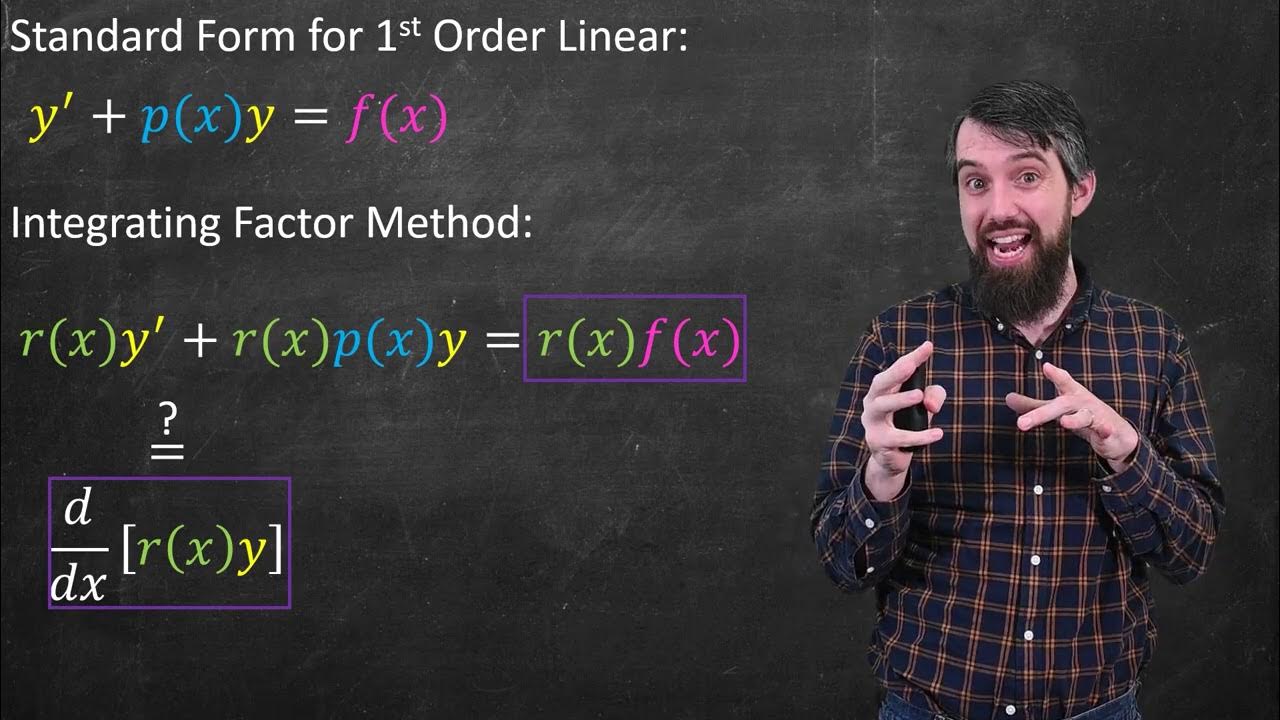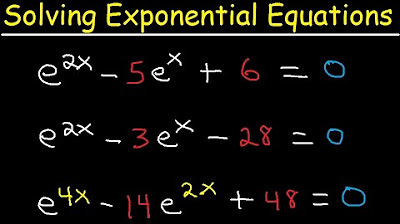An interesting second order differential equation
TLDRIn this video, we tackle solving a second-order differential equation: the second derivative of x with respect to t plus e to the x equals zero. The instructor starts by discussing notations and explores potential solutions, ruling out linear ones due to contradictions. By multiplying both sides by an integrating factor, the equation is transformed into a form that reveals constant properties. After performing variable changes and integration, the solution process concludes with two families of solutions for x, derived from exponential and logarithmic functions. The video provides a detailed walkthrough of each step, making the complex topic accessible.
Takeaways
- 📘 Introduction to solving a second-order differential equation.
- 🔢 The differential equation is the second derivative of x with respect to t plus e to the x equals zero.
- 📝 Notations used: x dot for the first derivative and x double dot for the second derivative.
- ❌ Linear functions are not solutions for this differential equation.
- ⚙️ Using an integrating factor to transform the equation.
- 🔍 Introducing a change of variables to simplify the equation.
- 🔄 The new differential equation is separable after the change of variables.
- ➗ Performing partial fraction decomposition to integrate.
- 📈 Solving the integrated equation to find the solutions for y.
- 🧮 Reverting to original variables to find the solutions for x.
Q & A
What is the main topic of the video?
-The main topic of the video is solving a second-order differential equation involving the second derivative of x with respect to t and e to the power of x.
What is the independent variable in the differential equation discussed?
-The independent variable in the differential equation is t.
What notation is used for the first and second derivatives of x with respect to t?
-The first derivative of x with respect to t is denoted by x dot, and the second derivative is denoted by x double dot.
Why can't the solution to the differential equation be a linear function?
-The solution can't be a linear function because substituting a linear function into the differential equation leads to a contradiction, as it results in an impossible equality.
What is the purpose of multiplying both sides of the equation by an integrating factor?
-Multiplying both sides by an integrating factor helps transform the right-hand side of the equation into the derivative of a certain function, simplifying the equation.
How is the left-hand side of the transformed equation represented?
-The left-hand side is represented as the derivative of (x dot squared over 2) plus e to the power of x.
What assumption is made to simplify the equation after introducing the integrating factor?
-The assumption made is that (x dot squared over 2) plus e to the power of x is equal to a positive constant.
How is the equation further simplified after taking the square root on both sides?
-After taking the square root, the equation becomes x dot equals plus or minus the square root of (2a squared minus e to the power of x).
What change of variable is introduced to solve the differential equation?
-The change of variable introduced is y equals the square root of (a squared minus e to the power of x).
What is the final form of the solution for x after solving the differential equation?
-The final form of the solution for x includes two families of solutions: x equals a times t plus the natural log of (4a squared b minus 2 times the natural log of b times e to the power of a times t plus 1), and another similar form with different parameters.
Outlines
📚 Introduction to Solving a Second Order Differential Equation
The video begins with an introduction to solving a second order differential equation, given by \( \frac{d^2x}{dt^2} + e^x = 0 \), where \( x \) is the function and \( t \) is the independent variable. The instructor proposes an initial guess for the solution, \( x(t) = at + B \), but quickly refutes it by differentiating and finding a contradiction with the original equation. The assumption that solutions cannot be constant is also highlighted. The process then moves on to multiplying both sides of the equation by an integrating factor to facilitate the solution, aiming to transform the right-hand side into the derivative of a function.
🔍 Detailed Solution Process for the Differential Equation
The instructor continues by multiplying the differential equation by \( x \cdot \dot{x} \) and recognizing that the left-hand side represents the derivative of \( \frac{\dot{x}^2}{2} + e^x \). Assuming this expression equals a constant \( a^2 \), the equation is then transformed into an algebraic one, solved for \( \dot{x} \), leading to \( \dot{x} = \pm \sqrt{2a^2 - e^x} \). A change of variable is introduced with \( y = \sqrt{a^2 - e^x} \), simplifying the equation into a separable form. After separating variables and integrating, the solution involves partial fraction decomposition and integration, leading to expressions for \( y \) and \( x \) in terms of exponential functions and natural logarithms. The video concludes with two families of solutions for \( x \), involving exponential and logarithmic functions of \( t \), and an invitation for viewers to subscribe, like, and share the content.
Mindmap
Keywords
💡Differential Equation
💡Second Derivative
💡Linear Function
💡Integrating Factor
💡Separable Differential Equation
💡Partial Fraction Decomposition
💡Natural Logarithm
💡Exponential Function
💡Solution of a Differential Equation
💡Variable Change
Highlights
Introduction to solving a second-order differential equation with an unknown function X and independent variable T.
Definition of notations: x dot as the first derivative of x with respect to T, and x double dot as the second derivative.
Assumption that X of t = a t + B is a solution, leading to a contradiction when substituted into the differential equation.
Explanation of why linear solutions, including constant solutions, are not possible for this differential equation.
Introduction of the integrating factor technique to transform the equation.
Detailed process of multiplying both sides of the equation by the integrating factor x dot.
Transformation of the left-hand side into the derivative of a specific function, showing it's equal to a constant.
Algebraic manipulation to solve for x dot, resulting in a new equation.
Introduction of a change of variables, setting Y equal to the square root of a^2 - e^x.
Transformation of the original differential equation into a separable differential equation in terms of Y.
Step-by-step integration of the transformed equation, leading to a solution for Y.
Using partial fraction decomposition to integrate the left-hand side of the equation.
Taking the exponential on both sides to solve for Y, leading to a final expression for Y in terms of T.
Finding e^x by substituting back Y into the original change of variables equation.
Deriving two families of solutions for x, expressed in terms of natural logarithms and exponential functions.
Conclusion with the final forms of the solutions and an encouragement to subscribe, like, and share the content.
Transcripts
Browse More Related Video

Linear Differential Equations & the Method of Integrating Factors

The Theory of 2nd Order ODEs // Existence & Uniqueness, Superposition, & Linear Independence

Initial Value Problem

Logarithmic Equations

First Order Linear Differential Equations

Solving Exponential Equations In Quadratic Form - Using Logarithms, With e
5.0 / 5 (0 votes)
Thanks for rating: